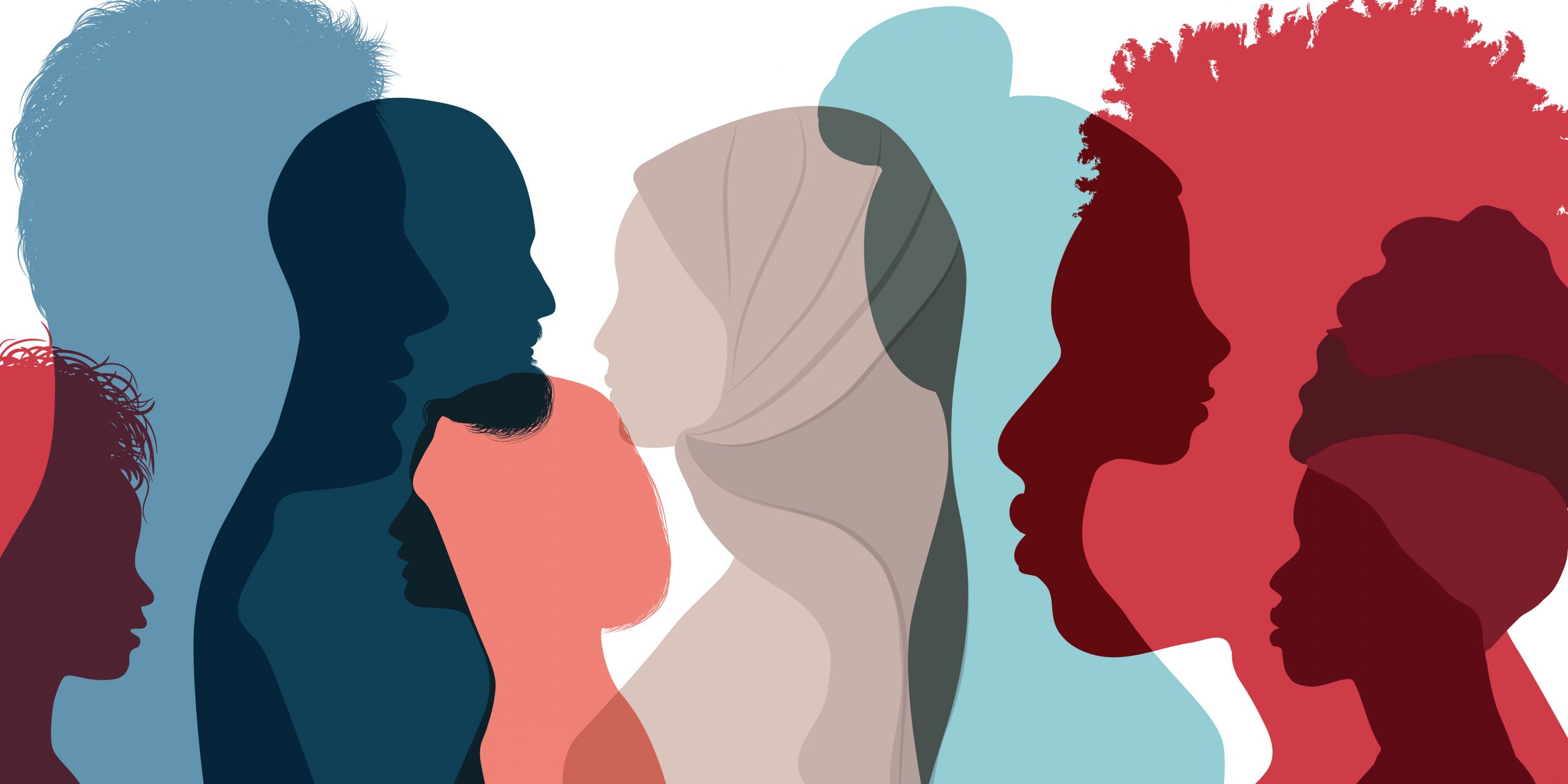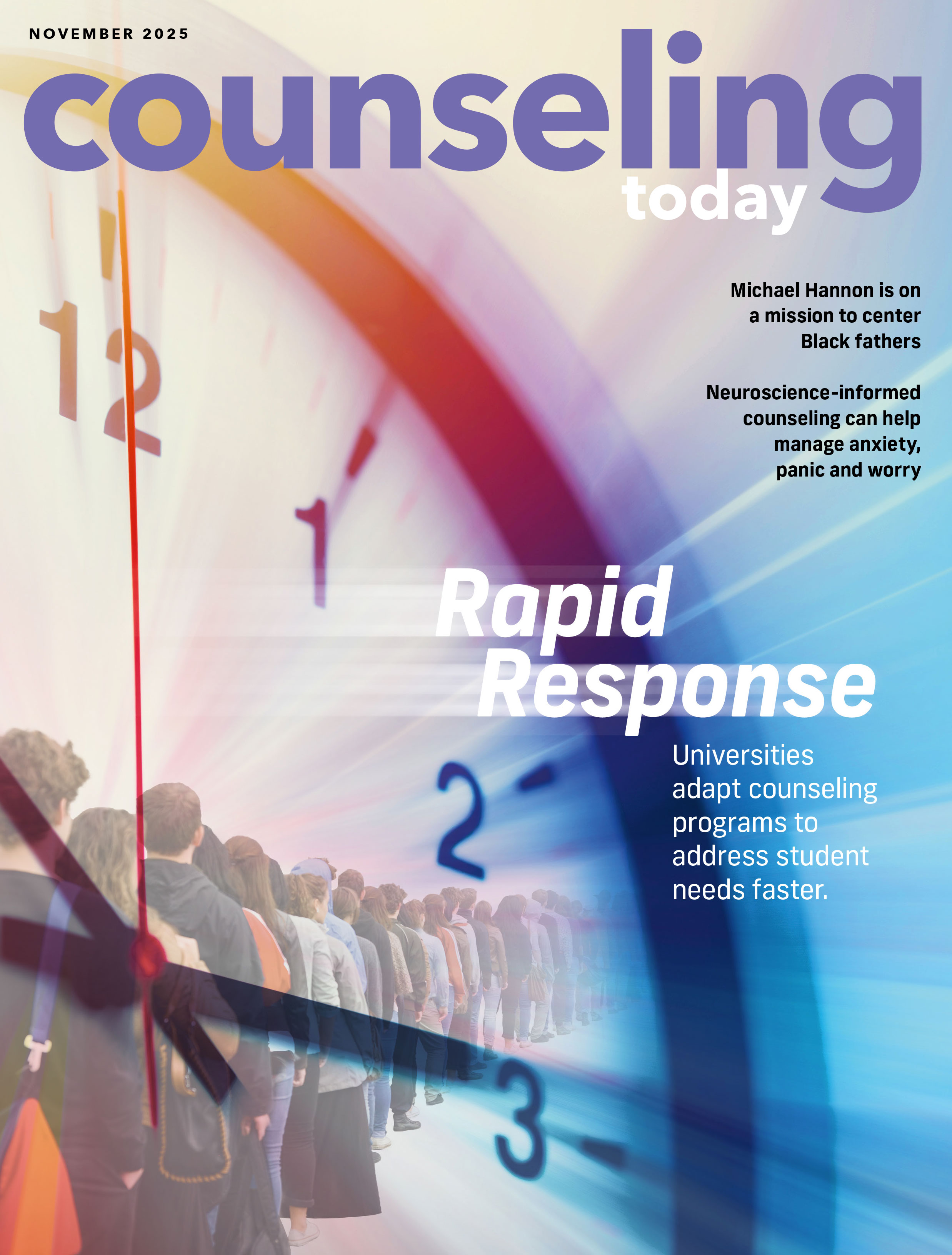Conceptualizing and assessing race-based traumatic stress
July 2023

 Counselors have a responsibility to promote and provide equitable care and treatment as outlined in the ACA Advocacy Competencies and the Multicultural and Social Justice Counseling Competencies.
To do so, counselors require awareness, knowledge and skills to work
effectively with Black American clients. Clinicians seeking to treat
Black American clients must understand that racial trauma is deeply
rooted in historical, generational and ongoing systemic oppression and
has a pervasive impact on the well-being of Black individuals and
communities. The toll of racism is implicated in health and mental
health disparities that can be addressed only through knowledge,
awareness and a commitment to culturally responsive care. Culturally
competent counseling requires specialized conceptualization, assessment
and treatment of racial trauma.
Counselors have a responsibility to promote and provide equitable care and treatment as outlined in the ACA Advocacy Competencies and the Multicultural and Social Justice Counseling Competencies.
To do so, counselors require awareness, knowledge and skills to work
effectively with Black American clients. Clinicians seeking to treat
Black American clients must understand that racial trauma is deeply
rooted in historical, generational and ongoing systemic oppression and
has a pervasive impact on the well-being of Black individuals and
communities. The toll of racism is implicated in health and mental
health disparities that can be addressed only through knowledge,
awareness and a commitment to culturally responsive care. Culturally
competent counseling requires specialized conceptualization, assessment
and treatment of racial trauma.
A foundational understanding is that racism is embedded in all aspects of daily life and is a common and frequent experience for Black Americans. Racial inequity has profound economic, health and mental health impacts. Racial disparities contribute to unequal access to employment, education, housing and other material resources. Black families are more likely to live in dangerous neighborhoods and areas of concentrated poverty, have limited employment and poor access to quality health care, and experience food deserts, all of which exacerbate the effects of poverty and impede access to opportunity. Racism contributes to mental health issues such as anxiety, depression and posttraumatic stress. Racism is implicated in the phenomenon of weathering — a trauma response related to repeated exposure to chronic stress and adversity — resulting in myriad chronic health issues including hypertension, obesity, heart disease and early death
The effects of racism extend to the counseling realm. Historically, racial trauma in Black American slaves was attributed to mental health conditions not believed to exist in other people. In 1851, Dr. Samuel Cartwright, who had apprenticed under Dr. Benjamin Rush, the “father of American psychiatry,” diagnosed two slave disorders he labeled “drapetomania” and “dysaesthesia aethiopica” (or “rascality”). Supposedly, drapetomania caused slaves to escape plantations; rascality was understood as an inherent trait of laziness and carelessness. Unfortunately, the idea of rascality continues to permeate views of Black Americans in relation to poor work ethic and criminality. The recommended treatment for both drapetomania and dysaesthesia aethiopica was physical torture. Today, these false diagnoses are associated with justifying police brutality and the harsh treatment of Black Americans facing legal authorities.
In counseling, Black Americans face an increased risk of
retraumatization because of inappropriate assessment, misdiagnosis and
poor treatment. Given this reality, and the resulting cultural mistrust
of health care professionals, it is not surprising that rates of
unilateral termination in counseling are much higher among Black
American clients.
Conceptualizing historical trauma and slavery’s lasting effects
Historical racial trauma reflects the unresolved collective grief and cultural wounding that are passed down generationally. The field of epigenetics highlights that negative environmental conditions and stressors affect human beings down to the cellular level. For Black Americans, the racial trauma of slavery underpins a soul injury of unresolved grief that affects the whole being. In this context, the social-cultural wound is a collective experience of an internalized racial injury so pervasive that it impacts Black American culture in distinct racialized ways.
Anti-Black racism is rooted in the belief that people of darker skin tones are uncivilized, savage and prone to violence, regardless of how much status, achievement and standing a Black person may attain. This manifests in the phenomenon of colorism — the preference for lighter skin tone and Eurocentric features. Counselors need to know that colorism affects all aspects of a Black person’s life and influences their life chances, both within and outside of the Black American community. Black Americans face greater likelihood of poverty, more restricted access to education, and higher rates of imprisonment, underemployment and health inequity the further removed they are from the white ideal.
Posttraumatic slave syndrome (PTSS) is a theory of historical
trauma that highlights the multifaceted impact of the violence of
slavery, institutionalized segregation and oppression, and ongoing
struggles for racial justice on the lives of Black Americans who are
descendants of enslaved Africans. Counselors need to know the theory of
PTSS, which was developed by researcher and educator Joy DeGruy-Leary to
describe the survival strategies that were necessary for enduring the
hostile conditions of slavery. PTSS accounts for both negative responses
and positive adaptations and can explain some of the behavioral
patterns of present-day Black Americans.
Controlling images and stereotypes
When Black American clients come to therapy, counselors should be aware of the controlling images and racial stereotypes these clients face.
The labeling starts early. In school, Black children are disciplined at higher rates than other children, with severe consequences that can include out-of-school suspensions, law enforcement involvement and, ultimately, even imprisonment for some Black children. Black boys are disciplined for being too “aggressive.” Black girls are disciplined for being “too loud” or dressing in a sexually provocative way. This reflects “adultification bias,” wherein school authorities hold Black girls to excruciatingly high standards because the girls are perceived to be more developed than they actually are. These responses stem from broader toxic stereotypes against Black Americans, deriving from slavery.
Controlling images underlie many of the mental health and stress-related concerns among Black women. One controlling image, the “Jezebel,” originated during slavery to justify the raping of Black women by white slave owners. It continues to have repercussions today in the increased risk of violent sexual assault against Black women due to the perception that they possess voracious sexual appetites and welcome aggression. The media also exploits the Jezebel trope and reinforces it in music videos, social media, television and movies, where Black women are often hypersexualized projections.
When counselors buy into the Jezebel myth, they risk misdiagnosing and mistreating sexually related concerns in therapy. Therefore, it is important to explore healthy sexual identity development and to challenge traumatic internalization of this controlling image. To further support and advocate for Black clients effectively, counselors need to be aware of these controlling images that discourage women from reporting sexual crimes and make it less likely they will be believed or find justice in court.
Another trope is the “Angry Black Woman.” This is routinely applied to Black women who are assertive and stand up in defiance of expectations of being demure and submissive. When they challenge injustice, they are labeled as domineering, masculine and emasculating. This combines racialized and gendered oppression and encourages the self-silencing of Black American women.
In response to these damaging stereotypes, Black American culture
sought to reclaim the dignity of Black femininity. This was done in
part by cultivating virtues of a Black matriarch who embodied strength,
self-reliance, care of others and emotional containment while being a
pillar of the community. In internalizing this “Strong Black Woman”
schema, however, Black women are under enormous pressure to achieve
excellence, block their emotions and care for others to the exclusion of
their own needs. If counselors are unaware of this schema, they may not
recognize the self-silencing, emotional dysregulation and fatigue that
are the result of an endless demand on Black women for strength and
voiceless endurance. Counselors should know that Black women who
internalize this schema are most at risk for pain-numbing behaviors such
as binge eating disorder, which is not about image or dieting, but
rather an emotional regulation strategy.
Microaggressions and racial trauma in daily life
Psychiatrist and Harvard University professor Chester M. Pierce first proposed the term “racial microaggressions” to describe brief, commonplace verbal or behavioral racial slights, whether intentional or unintentional, that communicate hostile, derogatory or negative insults toward Black Americans. Microaggressions are often veiled and ambiguous; for example, complimenting a Black person about how well-spoken they are. The implication is that the listener is surprised because they did not expect the Black person to be articulate.
The subtle nature of microaggressions makes them especially
frustrating for victims, who may be unsure of the intention behind the
slight and unclear about whether or how to respond. This distress is
damaging to a person’s well-being, especially when accumulated over
time. Microaggressions result in increased stress, anxiety, depression
and other trauma-related conditions. They can also lead to anger,
voicelessness, internalized self-devaluation and an assaulted sense of
self.
Race-based traumatic stress
Experiences with discrimination and oppression can result in race-based traumatic stress (RBTS), a term coined by researcher Robert Carter and colleagues to describe the significant stress Black Americans experience because of cultural, individual and institutional encounters with racism. Much like posttraumatic stress disorder (PTSD), RBTS carries psychological and physiological effects such as avoidance, hypervigilance, flashbacks, nightmares and somatic expressions (e.g., headaches, stomachaches, heart palpitations). At the same time, racial trauma differs from PTSD in significant ways. For instance, racial trauma involves ongoing cumulative injuries due to exposure, both direct (such as physical assault) and indirect (such as vicarious injury when other Black people are racially harmed or when witnessing racist incidents in person or in the media).
RBTS also includes reexposure to race-based stressors. Criteria include exposure to a racist event that is experienced as painful and uncontrollable. The traumatic reaction of avoidance, intrusion or arousal can manifest in several ways, including emotionally, cognitively, behaviorally and physiologically. Unfortunately, most of these wounds are easily overlooked if counselors do not understand race-based trauma symptomatology. Black American clients may need help in understanding and managing their strong reactions to these events. It is incumbent on counselors to have this awareness because Black American clients may not know that these exposures are considered traumatic.
The fact that racism is a stressor that can harm or injure its targets is still not recognized as an official diagnosis in the most recent iteration of the Diagnostic and Statistical Manual of Mental Disorders (DSM-5-TR). This decreases the chances that counselors can identify, assess and treat RBTS, even though researchers have reported higher rates of traumatic experiences among Black Americans when compared with the general population.
Although the current diagnostic criteria for PTSD in the DSM-5-TR is more expansive with respect to trauma generally, it does not account for the symptoms of RBTS due to its limiting of the types of experiences that lead to trauma. For instance, Criterion A specifies “exposure to actual or threatened death, serious injury or sexual violence” as the main diagnostic criteria, even though other types of stressful experiences, such as racism, have been linked to negative mental health outcomes.
Criterion A also contains a specific notification, under Criterion A4, that explicitly states “experiencing repeated or extreme exposure to aversive details of the traumatic event(s) does not apply to exposure through electronic media, television, movies or pictures, unless this exposure is work-related.” This is concerning because advancements in technology and the ubiquitous reach of media have increased the exposure of Black Americans to heightened images of racial injustice and trauma, such as the gruesome images, in real time, of the murder of George Floyd.
Similarly, newer forms of hate crimes have emerged in social media networks as a convenient means of transmitting hate. All of this can have the effect of retriggering and retraumatizing previous racialized experiences. Black American clients might present to counseling with trauma stirred up by these media exposures to racism, but it may not be apparent because of the everyday nature of these incidences. In addition, diagnosis is difficult because of the electronic media exclusion note in Criterion A4.
The current definition of PTSD in the DSM-5-TR is
problematic. It contributes to potential misdiagnosis and the
pathologizing of racial stress symptoms, and it limits the ability of
Black American clients to receive adequate racial trauma treatment.
Additionally, without an official diagnosis, health care insurance
coverage and reimbursement can be restricted.
RBTS assessment measures
Despite the limitations of the DSM-5-TR diagnostic criteria, counselors can still offer an appropriate assessment of RBTS, if they have the necessary knowledge and awareness and the proper tools. Experts in the racial trauma field have developed several scientifically validated instruments that accurately assess trauma symptomatology. Counselors can choose any of these instruments during a scheduled intake or following a session when a client presents with symptoms that may be indicative of racial trauma. These tools can help counselors assess Black American clients and develop treatment strategies for healing their traumatic experiences.
- The University of Connecticut Racial/Ethnic Stress & Trauma Scale (UnRESTS) uses an interview format to facilitate communication regarding clients’ experiences with racism. UnRESTS uses a two-column format: one column with instructions for the counselor to prepare the interview and the other column describing questions to ask the client. This measure is helpful for counselors who are inexperienced in identifying racial trauma or those who are hesitant to broach racially charged topics in counseling. It provides clinicians with a structure to conduct the interview, starting with identifying racial or ethnic identity development and moving through experiences of covert and overt racism, including vicarious racism. This provides counselors with the confidence that they have elicited the greatest input from their clients on these issues and can make a treatment plan based on this comprehensive review.
- The Race-Based Traumatic Stress Symptom Scale (RBTSSS) evaluates a client’s exposure to racist experiences and the symptoms that can result, including emotional and physiological reactivity. The measure includes 52 items in seven categories that explore self-esteem, physical reactions, anger, avoidance, depression, intrusion and hypervigilance or arousal, all associated with racial trauma. When using the RBTSSS, the clinician begins with open-ended questions to obtain information from the client about racist experiences. This is followed by closed-ended questions about the client’s reactions. A clinician can assist in administering this assessment, or it can be administered as a self-report measure.
- The General Ethnic Discrimination Scale (GEDS) is an instrument specially designed for measuring clients’ frequency of exposure to racism. It is appropriate to use with most ethnic groups affected by racial trauma. GEDS consists of 18 self-reported items that measure the client’s personal perception of racial discrimination. This tool is similarly structured to other existing stress inventories currently in use. Because this is a self-reporting tool, instructions have been simplified for participants whose first language is not English. It is also specifically useful when faced with time constraints because it is a relatively quick measure for assessing racial trauma.
- The Racial Microaggressions Scale (RMAS) is a tool measuring racial slights and the resulting distress of microaggressions. It specifically explores six types of microaggressions using a 32-item questionnaire in a Likert scale format. The distress subscales include criminality distress, low achieving/undesirable culture distress, sexualization distress, invisibility distress, foreigner distress and environmental distress. Counselors might choose this assessment when Black American clients report experiencing insults and invalidations that undermine their sense of self.
Because racial trauma is so deeply rooted in historical and generational oppression going back to slavery, Black Americans continue to experience the devastating toll. Counselors who work with Black Americans must understand the conceptualization of this experience and be competent in evaluating its impact on their clients.
////
Learn how to treat race-based traumatic stress in July’s Knowledge Share article “Treatment strategies for race-based traumatic stress.”
 Portia Allie-Turco is
an assistant professor, clinic director and program coordinator in the
Counselor Education Department at the State University of New York at
Plattsburgh. She is also a licensed mental health counselor who
specializes in healing racial, generational and complex trauma. Contact
her at p.allieturco@gmail.com.
Portia Allie-Turco is
an assistant professor, clinic director and program coordinator in the
Counselor Education Department at the State University of New York at
Plattsburgh. She is also a licensed mental health counselor who
specializes in healing racial, generational and complex trauma. Contact
her at p.allieturco@gmail.com.
The views expressed in Counseling Today are those of the authors and contributors and may not reflect the official policies or positions of the editors or the American Counseling Association.


